AMD's Radeon HD 5870: Bringing About the Next Generation Of GPUs
by Ryan Smith on September 23, 2009 9:00 AM EST- Posted in
- GPUs
Power, Temperature, & Noise
As we have mentioned previously, one of AMD’s big design goals for the 5800 series was to get the idle power load significantly lower than that of the 4800 series. Officially the 4870 does 90W, the 4890 60W, and the 5870 should do 27W.
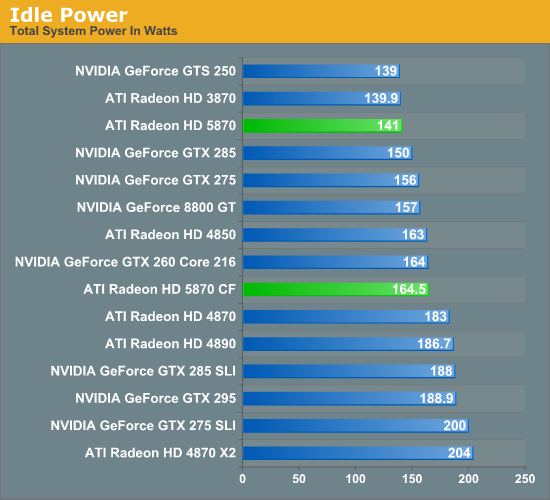
On our test bench, the idle power load of the system comes in at 141W, a good 42W lower than either the 4870 or 4890. The difference is even more pronounced when compared to the multi-GPU cards that the 5870 competes with performance wise, with the gap opening up to as much as 63W when compared to the 4870X2. In fact the only cards that the 5870 can’t beat are some of the slowest cards we have: the GTS 250 and the Radeon HD 3870.
As for the 5870 CF, we see AMD’s CF-specific power savings in play here. They told us they can get the second card down to 20W, and on our rig the power consumption of adding a second card is 23.5W, which after taking power inefficiencies into account is right on the dot.
Moving on to load power, we are using the latest version of the OCCT stress testing tool, as we have found that it creates the largest load out of any of the games and programs we have. As we stated in our look at Cypress’ power capabilities, OCCT is being actively throttled by AMD’s drivers on the 4000 and 3000 series hardware. So while this is the largest load we can generate on those cards, it’s not quite the largest load they could ever experience. For the 5000 series, any throttling would be done by the GPU’s own sensors, and only if the VRMs start to overload.
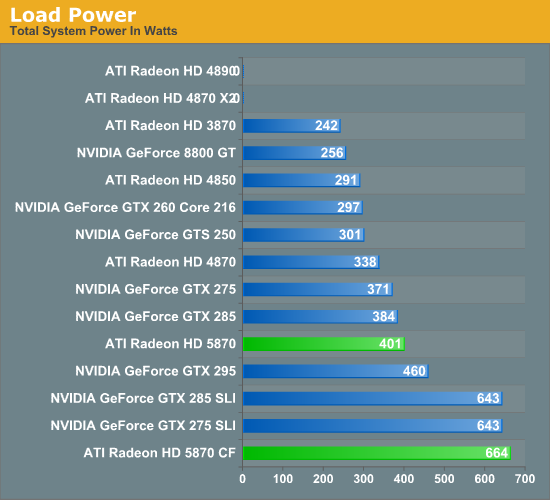
In spite of AMD’s throttling of the 4000 series, right off the bat we have two failures. Our 4870X2 and 4890 both crash the moment OCCT starts. If you ever wanted proof as to why AMD needed to move to hardware based overcurrent protection, you will get no better example of that than here.
For the cards that don’t fail the test, the 5870 ends up being the most power-hungry single-GPU card, at 401W total system power. This puts it slightly ahead of the GTX 285, and well, well behind any of the dual-GPU cards or configurations we are testing. Meanwhile the 5870 CF takes the cake, beating every other configuration for a load power of 664W. If we haven’t mentioned this already we will now: if you want to run multiple 5870s, you’re going to need a good power supply.
Ultimately with the throttling of OCCT it’s difficult to make accurate predictions about all possible cases. But from our tests with it, it looks like it’s fair to say that the 5870 has the capability to be a slightly bigger power hog than any previous single-GPU card.
In light of our results with OCCT, we have also taken load power results for our suite of cards when running World of Warcraft. As it’s not a stress-tester it should produce results more in line with what power consumption will look like with a regular game.

Right off the bat, system power consumption is significantly lower. The biggest power hogs are the are the GTX 285 and GTX 285 SLI for single and dual-GPU configurations respectively. The bulk of the lineup is the same in terms of what cards consume more power, but the 5870 has moved down the ladder, coming in behind the GTX 275 and ahead of the 4870.
Next up we have card temperatures, measured using the on-board sensors of the card. With a good cooler, lower idle power consumption should lead to lower idle temperatures.
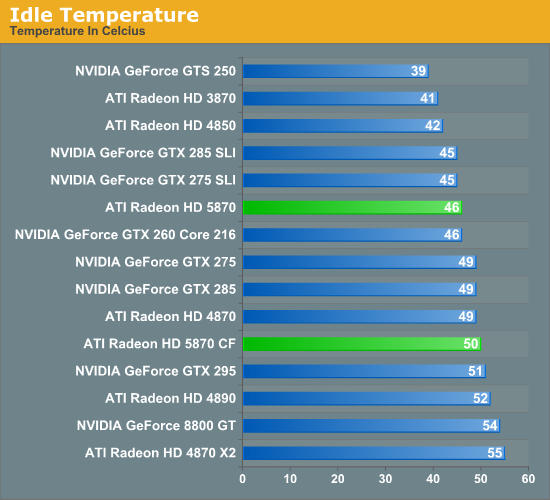
The floor for a good cooler looks to be about 40C, with the GTS 250, 3870, and 4850 all turning in temperatures around here. For the 5870, it comes in at 46C, which is enough to beat the 4870 and the NVIDIA GTX lineup.
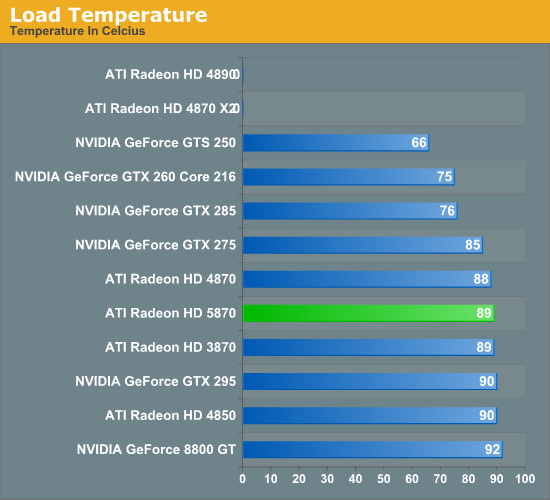
Unlike power consumption, load temperatures are all over the place. All of the AMD cards approach 90C, while NVIDIA’s cards are between 92C for an old 8800GT, and a relatively chilly 75C for the GTX 260. As far as the 5870 is concerned, this is solid proof that the half-slot exhaust vent isn’t going to cause any issues with cooling.
Finally we have fan noise, as measured 6” from the card. The noise floor for our setup is 40.4 dB.

All of the cards, save the GTX 295, generate practically the same amount of noise when idling. Given the lower energy consumption of the 5870 when idling, we had been expecting it to end up a bit quieter, but this was not to be.
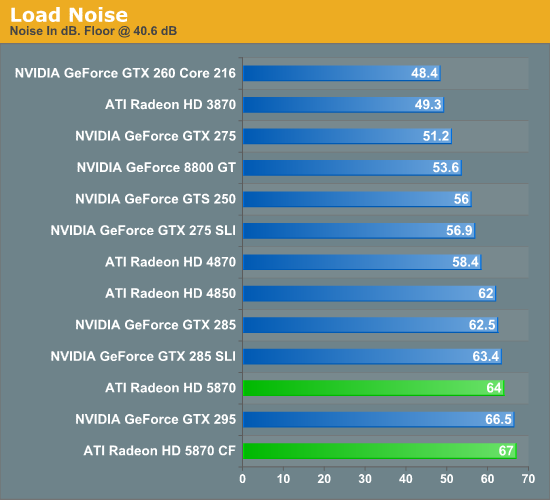
At load, the picture changes entirely. The more powerful the card the louder it tends to get, and the 5870 is no exception. At 64 dB it’s louder than everything other than the GTX 295 and a pair of 5870s. Hopefully this is something that the card manufacturers can improve on later on with custom coolers, as while 64 dB at 6" is not egregious it’s still an unwelcome increase in fan noise.










327 Comments
View All Comments
mapesdhs - Saturday, September 26, 2009 - link
MODel3 writes:
> 1.Geometry/vertex performance issues ...
> 2.Geometry/vertex shading performance issues ...
Would perhaps some of the subtests in 3DMark06 be able to test this?
(not sure about Vantage, never used that yet) Though given what Jarred
said about the bandwidth and other differences, I suppose it's possible
to observe large differences in synthetic tests which are not the real
cause of a performance disparity.
The trouble with heavy GE tests is, they often end up loading the fill
rates anyway. I've run into this problem with the SGI tests I've done
over the years:
http://www.sgidepot.co.uk/sgi.html">http://www.sgidepot.co.uk/sgi.html
The larger landscape models used in the Inventor tests are a good
example. The points models worked better in this regard for testing
GE speed (stars3/star4), but I don't know to what extent modern PC
gfx is designed to handle points modelling - probably works better
on pro cards. Actually, Inventor wasn't a good choice anyway as it's
badly CPU-bound and API-heavy (I should have used Performer, gives
results 5 to 10X faster).
Anyway, point is, synthetic tests might allow one to infer that one
aspect of the gfx pipeline is a bottleneck when infact it isn't.
Ages ago I emailed NVIDIA (Ujesh, who I used to know many moons ago,
but alas he didn't reply) asking when, if ever, they would add
performance counters and other feedback monitors to their gfx
products so that applications could tell what was going on in the
gfx pipeline. SGI did this ages years ago, which allowed systems like
IR to support impressive functions such as Dynamic Video Resizing by
being able to monitor frame by frame what was going on within the gfx
engine at each stage. Try loading any 3D model into perfly, press F1
and click on 'Gfx' in the panel (Linux systems can run Performer), eg.:
http://www.sgidepot.co.uk/misc/perfly.gif">http://www.sgidepot.co.uk/misc/perfly.gif
Given how complex modern PC gfx has become, it's always been a
mystery to me why such functions haven't been included long ago.
Indeed, for all that Crysis looks amazing, I was never that keen on
it being used as a benchmark since there was no way of knowing
whether the performance hammering it created was due to a genuinely
complex environment or just an inefficient gfx engine. There's still
no way to be sure.
If we knew what was happening inside the gfx system, we could easily
work out why performance differences for different apps/games crop
up the way they do. And I would have thought that feedback monitors
within the gfx pipe would be even more useful to those using
professional applications, just as it was for coders working on SGI
hardware in years past.
Come to think of it, how do NVIDIA/ATI even design these things
without being able to monitor what's going on? Jarred, have you ever
asked either company about this?
Ian.
JarredWalton - Saturday, September 26, 2009 - link
I haven't personally, since I'm not really the GPU reviewer here. I'd assume most of their design comes from modeling what's happening, and with knowledge of their architecture they probably have utilities that help them debug stuff and figure out where stalls and bottlenecks are occurring. Or maybe they don't? I figure we don't really have this sort of detail for CPUs either, because we have tools that know the pipeline and architecture and they can model how the software performs without any hardware feedback.MODEL3 - Thursday, October 1, 2009 - link
I checked the web for synthetic geometry tests.Sadly i only found 3dMark Vantage tests.
You can't tell much from them, but they are indicative.
Check:
http://www.pcper.com/article.php?aid=783&type=...">http://www.pcper.com/article.php?aid=783&type=...
GPU Cloth: 5870 is only 1,2X faster than 4890. (vertex/geometry shading test)
GPU Particles: 5870 is only 1,2X faster than 4890. (vertex/geometry shading test)
Perlin Noise: 5870 is 2,5X faster than 4890. (Math-heavy Pixel Shader test)
Parallax Occlusion Mapping: 5870 is 2,1X faster than 4890. (Complex Pixel Shader test)
All the above 4 tests are not bandwidth limited at all.
Just for example, if you check:
http://www.pcper.com/article.php?aid=674&type=...">http://www.pcper.com/article.php?aid=674&type=...
You will see that a 750MHz 4870 512MB is 20-23% faster than a 625MHz 4850 in all the above 4 tests, so the extra bandwidth (115,2GB/s vs 64GB/s) it doesn't help at all.
But 4850 is extremely bandwidth limited in the color fillrate test (4870 is 60% faster than 4850)
Also it shouldn't be a problem of the dual rasterizer/dual SIMDs engine efficiency since synthetic Pixel Shader tests is fine (more than 2X) while the synthetic geometry shading tests is only 1,2X.
My guess is ATI didn't improve the classic geometry set-up engine and the GS because they want to promote vertex/geometry techniques based on the DX11 tesselator from now on.
Zool - Friday, September 25, 2009 - link
In Dx11 the fixed tesselation units will do much finer geometry details for much less memmory space and on chip so i think there isnt a single problem with that. Also the compute shader need minimal memory bandwith and can utilize plenty of idle shaders. The card is designed with dx11 in mind and it isnt using the wholle pipeline after all. I wouldnt make too early conclusions.(I think the perfomance will be much better after few drivers)MODEL3 - Saturday, September 26, 2009 - link
The DX11 tesselator in order to be utilized must the game engine to take advantage of it.I am not talking about the tesselator.
I am talking about the classic Geometry unit (DX9/DX10 engines) and the Geometry Shader [GS] (DX10 engines only).
I'll check to see if i can find a tech site that has synthetic bench for Geometry related perf. and i will post again tomorrow, if i can find anything.
JarredWalton - Friday, September 25, 2009 - link
It's worth noting that when you factor in clock speeds, compared to the 5870 the 4870X2 offers 88% of the core performance and 50% more bandwidth. Some algorithms/games require more bandwidth and others need more core performance, but it's usually a combination of the two. The X2 also has CrossFire inefficiencies to deal with.More interesting perhaps is that the GTX 295 offers (by my estimates, which admittedly are off in some areas) roughly 10% more GPU shader performance, about 18.5% more fill rate, and 46% more bandwidth than the HD 5870. The fact that the HD 4870 is still competitive is a good sign that ATI is getting good use of their 5 SPs per Stream Processor design, and that they are not memory bandwidth limited -- at least not entirely.
SiliconDoc - Wednesday, September 30, 2009 - link
The 4870x2 has somewhere around "double the data paths" in and out of it's 2 cpu's. So what you have with the 5870 putting as some have characterized " 2x 770 cores melded into one " is DOUBLE THE BOTTLENECK in and out of the core.They tried to compensate with ddr5 1200/4800 - but the fact remains, they only get so much with that "NOT ENOUGH DATA PATHS/PINS in and out of that gpu core."
cactusdog - Friday, September 25, 2009 - link
Omg these cards look great. Lol Silicon Doc is so gutted and furious he is making hmself look like a dam fool again only this time he should be on suicide watch...Nvidia cards are now obsolete..LOL.mapesdhs - Friday, September 25, 2009 - link
Hehe, indeed. Have you ever seen a scifi series called, "They Came
From Somewhere Else?" S.D.'s getting so worked up, reminds me of
the scene where the guy's head explodes. :D
Hmm, that's an alternative approach I suppose in place of post
moderation. Just get someone so worked up about something they'll
have an aneurism and pop their clogs... in which case, I'll hand
it back to Jarred. *grin*
Ian.
SiliconDoc - Friday, September 25, 2009 - link
That is quite all right, you fellas make sure to read it all, I am more than happy that the truth is sinking into your gourds, you won't be able to shake it.I am very happy about it.